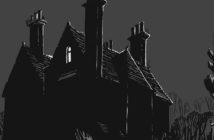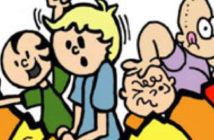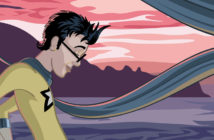Simply put, Harbor Moon is one of the finest comics I’ve read all year. This book—written by Ryan Colucci and Dikran Ornekian and illustrated by Pawel Sambor—truly has something to offer fans of horror and dark fantasy: a feverish premise, an intense narrative, haunting artwork and colors, and a murky atmosphere latent with danger and dread. And, for added effect, the ending is even a bit optimistic. Isn’t that an interesting twist?
For weeks now, I’ve been referring to my Sunday television viewing as “Supernatural Sunday”—I can’t get enough of HBO’s True Blood or ABC’s The Gates. It’s no secret that both are supernatural dramas, but True Blood is far more crazed, whereas The Gates is sober and rational. It has to be: network television would never allow the steamy sex and oozing violence of True Blood on network cable.
And yet, I lean towards The Gates as my favorite of the two because of the heated subcultures and angry turf wars going on within the show’s gated community of the supernatural. Among the monsters inside are werewolves, creatures that follow rules and regulations so strict and so inline with the tenets of social Darwinism that even the most ardent follower of Ayn Rand would blush.
That very same culture exists within the feral community of Harbor Moon, a seemingly quiet and sleepy town tucked away in the dense forests of Maine. There must be something about the state of Maine that attracts dark secrets: the 1970s gothic soap opera Dark Shadows was set in the fictional Maine town of Collinsport, as is Stephen King’s often-used waterfront village of Castle Rock.
But Harbor Moon is much bleaker and more desolate than either Collinsport or Castle Rock. We first see the town a few pages into the book as the protagonist, Timothy “Tim” Vance, drives into town. Vultures and crows are perched atop the trees looming overhead. The buildings appear abandoned. Livestock roams the streets freely. The diner only offers meals of meat, extra bloody. Tim doesn’t even find another living soul until he walks into the local tavern looking for a room. He’s told several times that the town doesn’t take kindly to strangers. He’s been warned.
Tim is tightlipped about his reasons for appearing in the wayward settlement, but we as the audience soon learn that he’s there looking for his long-lost father, Andrew O’Callaghan, a man he talked to only once in his life. In that conversation, Andrew pleaded with his son to visit him in his hometown of Harbor Moon, and he agrees. But Tim eventually learns that his father has died all too recently, and in order to solve the mystery, he has to pierce the dark veil of secrecy that protects the town from the outside world. It’s worth noting at this point that werewolves are involved with Harbor Moon and all of its inhabitants, but I’ll leave it at that.
What’s so interesting about Harbor Moon is its successful usage of old formulas. It’s almost impossible to tell a story in the dark fantasy or horror genre without invoking the feelings of isolation and claustrophobia; that’s exactly why so many stories have lone and troubled heroes roaming around haunted houses and ghostly towns. They’re alone and susceptible to danger, and therefore, we as the readers are as well. Writers Colucci and Ornekian both flawlessly create this vital atmospheric element. Harbor Moon as a place is constructed from a classic formula, but one that exists on its own terms.
When Harbor Moon isn’t trying to invoke fear, it’s tapping into the instinctual nature of man. It’s no accident that Tim Vance is a former soldier, trained by the Special Forces and having completed three tours in the Middle East. He’s a tough and stoic guy, but soft-spoken and respectful of those around him. When he wanders into the town’s diner, Tim is confronted by Patrick, the local roughneck who does what he can to shake the newcomer up. These kinds of fights are common in Harbor Moon, but they’re not just bloody brawls, though many of them are, in fact, bloody brawls. They’re tests of sheer strength, will, and survival.
Artist Pawel Sambor’s work on this book is inspirational. His illustrations oftentimes look like conjurations of the blackest sorcery, and I have not been this impressed by the use of color in a comic book since Nektarios Chrissos and George Martzoukos’ Aposperos back in March. There are certain shots that are simply spellbinding, such as a full-page panel of Tim searching the abandoned home of his father: it’s an image of heavy shadows broken with the orange glow of a flashlight. It’s so effective that I could feel the heaviness of the air right alongside Tim. There are also several pages that mimic a tattered history book chronicling the founding of Harbor Moon. These pages demonstrate better than any other the depth of imagination the creators have brought to the book. All of this is controlled by masterful panel constructions that look like they were laid out by a pro.
This is Ryan Colucci’s first comic book, and one that he’s credited for co-writing, editing, and even producing. That’s code for financing the book, which I’m sure was no small bill. Aside from the content, the physical book itself is of the highest quality—it’s simply beautiful. It’s not a standard 10 x 7 size, but rather a larger 10 x 8 book with amazing production value in terms of paper and ink quality. If this is Colucci’s first comic, I can only imagine what his future books will be like.
In addition to the Colucci, Ornekian, and Sambor, there are a few other collaborators that made Harbor Moon possible. The book is based on a story developed by Brian Anderson, Karol Wisniewski served as the art director, and Nikodem Cabala worked with Sambor as the supporting artist. This team pulled together a genuinely impressive piece of work, something that is always a delight to find in the small publishing scene. Harbor Moon is one of the year’s best independent comics.
This comic book review originally appeared on Broken Frontier.



